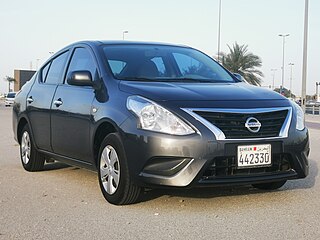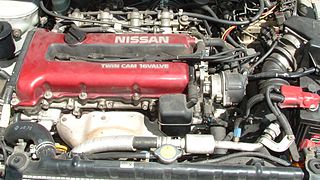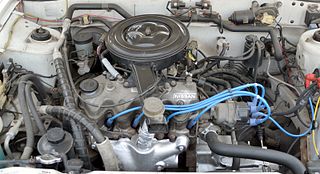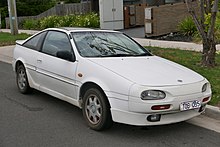
The QR family of inline-four piston engines by Nissan were introduced in 2000 and range from 2.0 to 2.5 L in displacement. These motors are aluminum, dual overhead camshaft (DOHC), four-valve designs with variable valve timing and optional direct injection. The engine shares much of its architecture with the YD diesel engine.

The Nissan Sunny is an automobile built by the Japanese automaker Nissan from 1966 till 2004. In the early 1980s, the brand changed from Datsun to Nissan in line with other models by the company. Although production of the Sunny in Japan ended in 2004, the name remains in use in China and GCC countries for a rebadged version of the Nissan Almera.

The QG engine is a 1.3 L (1,295 cc), 1.5 L (1,497 cc), 1.6 L (1,597 cc) and 1.8 L (1,769 cc) straight-4 piston engine from Nissan. It is a lean-burn aluminum DOHC 4-valve design with variable valve timing and optional NEO Di direct injection.

The SR engine is a series of 1.6 L (1,596 cc), 1.8 L (1,838 cc) or 2.0 L (1,998 cc) straight-four, four-stroke gasoline engines manufactured by Nissan. It has an aluminium head and block with steel sleeves and has a DOHC 4-valve design, with variable valve timing on select models.

The GA engine is a 1.3 to 1.6 L inline-four piston engine from Nissan. It has a cast-iron block and an aluminum head. There are SOHC and DOHC versions, 8, 12, and 16 valve versions, carbureted, single-point, and multi-point injected versions, and versions with variable valve timing (GA16DE). The GA was produced from August 1987 through 2013. Since 1998, it was only available from Mexico in the B13.

The Nissan Sentra is a series of automobiles manufactured by the Japanese automaker Nissan since 1982. Since 1999, the Sentra has been categorized as a compact car, while previously it occupied the subcompact class. Until 2006, Sentra was a rebadged export version of the Japanese Nissan Sunny, but since the 2013 model year, Sentra is a rebadged export version of the Sylphy. The Sentra nameplate is not used in Japan. Many other countries in Latin America sell their versions of the Sunny as the Sentra. In Mexico, the first three generations of the Sentra were known as the Nissan Tsuru, and the B13 model was sold under that name until 2017, alongside the updated models badged as Sentra.

The CA engine is a series of 1.6 to 2.0 L Inline-4 piston engines from Nissan. It is designed for a wide variety of smaller Nissan vehicles to replace the Z engine and some smaller, four-cylinder L series engines. The "CA" stands for Clean Air, due to the installation of Nissan emission reducing technology, called NAPS-X.

The Nissan Pulsar is a line of automobiles produced by the Japanese automaker Nissan from 1978 until 2000, when it was replaced by the Nissan Bluebird Sylphy in the Japanese market.

The Nissan AD is a subcompact van and wagon built by Nissan since 1982. The AD is sold under a different name when manufactured as a passenger car, called the Nissan Wingroad.

The SR20DET is a 2.0 L (1,998 cc) straight-four four-stroke gasoline engine that is part of the SR family of engines from Nissan, produced from 1989 to 2002. It is a turbocharged version of the SR20DE engine and is a replacement of the CA18DET engine.

The Nissan E series name was used on two types of automobile engines. The first was an OHV line used in the late 1950s and throughout the 1960s. The second was an OHC version ranging from 1.0 to 1.6 litres and was produced from 1981 till 1988. It was replaced by the GA engine series.

The Nissan S20 engine 2.0 L (1,989 cc) was a straight-6 four-valve DOHC internal combustion engine produced by Nissan from 1969 to 1973, originally designed by engineers of the former Prince. It was the first mass-produced Japanese engine with more than two valves per cylinder.

The GA16DE is an inline-four engine made by Nissan which is found in many Nissan models, like the Nissan Sunny, the Nissan Almera (N15), and the Nissan Primera 100NX. It is very similar to the GA14DE, aside from a larger displacement.

Most of the information in this section was translated from the Nissan Presea article on Japanese Wikipedia at ja:日産・プレセア.

The HR is a family of straight-3 12-valve and straight-4 16-valve automobile engines with continuously variable valve timing, involving development by Nissan and/or Renault, and also Mercedes-Benz in the case of the H5Ht/M282. The designation of H engine is used by Renault, and M28x by Mercedes-Benz, to classify the family. There are three basic specifications of engine involving variations in engine architecture, or all-new architecture, with 72.2 mm (2.84 in), 75.5 mm (2.97 in) and 78 mm (3.07 in) bore diameter.

The Datsun Cherry (チェリー), known later as the Nissan Cherry, was a series of subcompact cars which formed Nissan's first front-wheel drive supermini model line.

The Nissan Sylphy is a compact car produced by the Japanese car maker Nissan since 2000 as the successor to the Nissan Pulsar. The Sylphy has also been marketed in export markets under several other nameplates, including Pulsar, Almera, Sunny and Sentra. For the third-generation model (B17) introduced in 2012, the Sylphy model was merged with the B17 Sentra, meaning it is no longer a standalone model.

The Nissan Lucino is a small automobile nameplate used by the Japanese manufacturer Nissan between 1994 and 2000. The Lucino name applied simultaneously to a pair of entirely different vehicles—a two-door coupé version of the Sunny/Sentra (B14)—and badge engineered versions of the Nissan Pulsar (N15) three- and five-door hatchbacks. For Japan, coupés arrived first in 1994, followed by hatchbacks in 1995. Production in Japan ended in 1999, except for the five-door that lingered on until 2000.
The Nissan Pulsar EXA and Nissan EXA are automobiles manufactured and marketed by Nissan Motor Company from 1983 to 1986 and from 1986 to 1990 respectively. The first generation model was internally designated as the N12 series and was marketed in Japan at Nissan Cherry Store locations as the Pulsar EXA. The second generation EXA was designated as the N13 series.

The Nissan Silvia is the series of small sports cars produced by Nissan. Versions of the Silvia have been marketed as the 200SX or 240SX for export, with some export versions being sold under the Datsun brand.






















